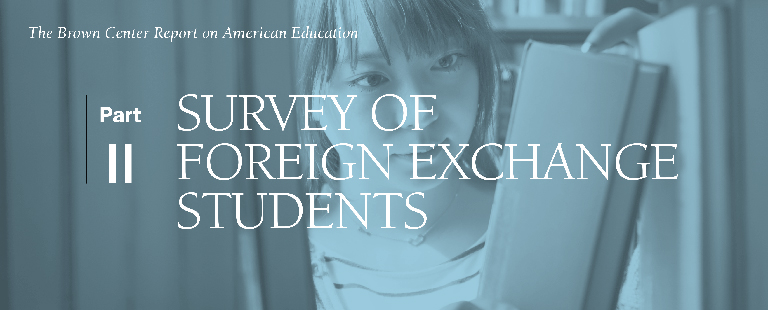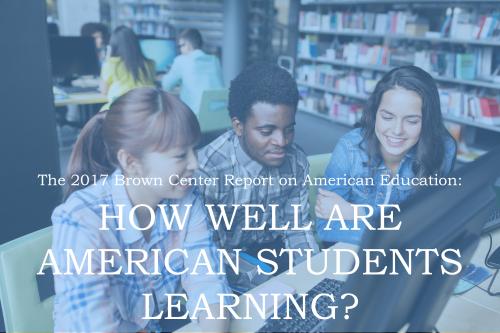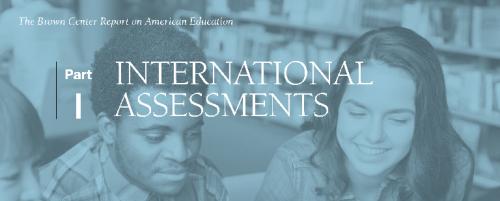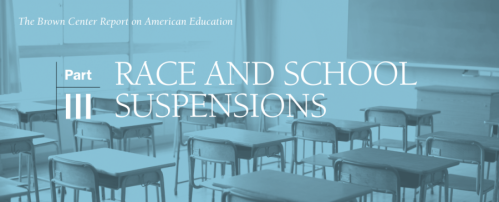The following is Part II of the 2017 Brown Center Report on American Education.

In the fall of 1957, James Coleman began surveying students in 10 high schools in northern Illinois. The sample was not randomly drawn. Schools were selected to reflect varying sizes (150 to 1,850) and communities (small towns, suburbs, and cities), serving students whose parents worked at varying occupations (farming, industrial, and professional). One of the schools was an all-boys Catholic school; the rest were public schools.
Coleman was careful to acknowledge that the sample was not designed to be representative of high schools in general, or even of high schools in northern Illinois, and that the results could not be generalized to a larger population. Despite these limitations, when the findings appeared in “The Adolescent Society,” published in 1961, the book was instantly recognized as a classic in the study of education.
Coleman’s unique insight was that modernity had given birth to a social unit unknown to previous generations, an adolescent subculture with its own values, norms, language, and status system. Although the 20th century had dawned with most Americans leaving school for work after completing eighth grade (only 11% of high-school-aged teens in 1900 actually attended high school), by the 1950s high school attendance had become nearly universal. Unlike families of agrarian societies, the modern family no longer served as society’s primary economic unit. The modern high school walled off adolescents from adult society and, by extending the length of time for youths’ education, delayed entry into adulthood. Consequently, Coleman argued, this age-segregated world “comes to constitute a small society, one that has most of its important interactions within itself, and maintains only a few threads of connection with the outside adult society.”1
Coleman found high schools remarkably anti-academic. Peer status underpinned a caste-like system with athletes at the top and brilliant students further down the social hierarchy. Coleman noted the irony of academic learning receiving so few status rewards among teens. The main reason children go to school, as reflected in compulsory education laws, is to learn, not to play sports.
THE CURRENT STUDY
In the six decades since Coleman’s study, education researchers have frequently surveyed teens and asked them about their school experiences. In 2001, it dawned on researchers in the Brown Center that one particular group of teens, foreign exchange students, had never been singled out for special consideration. We believed this group of teenagers could offer a fresh perspective on U.S. high schools. They are also teenagers; most of them attend modern high schools populated by children of a similar age, and with the worldwide diffusion of adolescent culture, surely share some of the same views as American teens. Perhaps they could also shed light on what is peculiarly American about American high schools.
In the spring of 2001, we conducted a survey of students from abroad who were nearing the end of their academic year in U.S. schools. The results appeared in the 2001 Brown Center Report. In the summer and fall of 2001, we replicated the survey with U.S. students who had gone abroad to attend high school, asking them the same set of questions. Those results appeared in the 2002 Brown Center Report.
It is time to replicate at least a portion of that study. In the spring of 2016, a survey of foreign exchange students was conducted. The same set of questions asked in 2001, with a few modifications, was asked once again. Has anything changed over the past 15 years? A random sample of 600 foreign exchange students was drawn from a list of all international students attending U.S. high schools under the auspices of AFS International. The survey was conducted by mail. Responses were received from 259 students (28 surveys were returned as undeliverable) for a response rate of 45.3%.
In the analysis below, the discussion will focus on the impressions of foreign exchange students regarding U.S. education, and how those impressions have changed since the surveys that were conducted in 2001.
WHAT DO STUDENTS DO OUTSIDE OF SCHOOL?
We asked the international students how they spend time in their home country when they are not in school. Figure 2-1 shows the out-of-school activities that students spend more than three hours per week doing. Homework or studying is the dominant activity. Four out of 10 students (40.2%) report spending at least three hours studying or doing homework each week, significantly more than 28.9% with the same response in 2001. Social media, which was not included on the 2001 survey, also gets a lot of time, with 23.6% of respondents naming it as a popular activity. Note that the percentage of students saying they spend three or more hours with friends dropped sharply from 2001 to 2016 (29.0% to 15.4%). A significant portion of teens’ social lives is now online.
More international students devoted three hours a week reading books for pleasure in 2016 (8.1%) than in 2001 (3.0%). That trend is the opposite of an apparent decline in reading for pleasure among U.S. teens.2 On the 2015 NAEP, 37% of U.S. 12th graders said they never read for pleasure, up from 30% in 2005.3 That raises an important point: the percentage of foreign exchange students saying they spent “no time” reading for pleasure (not shown in the figure) also increased—from 26.4% to 31.3%. The increase is not statistically significant, but it does show that, as in the U.S., a large proportion of teens abroad do not read for pleasure at all.
Note: The frequencies between 2001 and 2016 were significantly different (at the p<0.05 level) on the following activities: friends, reading a book, and studying/homework
PART-TIME JOBS
Whether students should work during high school has long been debated. Light (1995) analyzed data from the National Longitudinal Survey of Youth (NLSY) and discovered a wage benefit of about 10% that lasts approximately five years after high school graduation but then dissipates. Does part-time employment affect student performance at school? Marsh and Kleitman’s (2005) analysis of the National Education Longitudinal Study of 1988 (NELSS88) found negative effects of working during high school on achievement, coursework selection, educational and occupational aspirations, and college attendance. Kalenkoski and Pabilonia (2011), analyzing data from the American Time Use Surveys, found that employment reduces the amount of time students devote to homework, with one hour spent on work associated with 11 fewer minutes spent on homework.
Compared to teens abroad, American teens are unique in working part time during high school. Studies in the 1990s indicated that about two-thirds to three-quarters of U.S. high school students were employed at some point during their high school careers, much more than frequencies found in other countries. That contrast was apparent in the Brown Center Report’s 2001 surveys. Only 20% of students from abroad reported holding down a part time job while attending high school in their home countries. Compare that to U.S students who went abroad as exchange students: slightly more than half (55%) said they worked part time.
International students surveyed in 2016 indicate employment rates comparable to their counterparts 15 years ago (see Figure 2-2). Almost eight out of 10 (79.9%) do not work and only 5.8% spend more than five hours working at a job. In the 2001 survey of American students who studied abroad, more than a third (35%) said they spent more than five hours per week working.
U.S. exchange students are the appropriate comparison group, but we did not survey them in 2016. The 2001 statistics may need updating. Recent data from the Bureau of Labor Statistics suggest that only about half as many American teens are now working compared to 2000, a downward trend that accelerated during the Great Recession. Another caveat is that regulations that govern youth employment and place restrictions on the number of hours young people are allowed to work may have changed since 2001. 4
TIME SPENT ON SCHOOLWORK
The survey asked students the following: Compared to students in your home country, do you think U.S. students spend more, less, or about the same amount of time on schoolwork? Responses from both 2001 and 2016 are displayed in Figure 2-3. International students think American students devote less time to schoolwork. In 2001, 34.0% said much less, a figure that grew to 44.0% in 2016. When the 20.5% who answered “a little less” are also considered, it means that nearly two-thirds of foreign exchange students (64.5%) believe U.S. high school students spend less time on schoolwork than their peers do back home.
ARE U.S. CLASSES EASIER OR HARDER?
In the 2001 survey, foreign exchange students reported that high school classes in the U.S. seemed easier than classes in their home countries. When asked to rate the relative difficulty of U.S. classes, 56% replied “a lot easier” and 29% said “a little easier.” Only 6% said “a little harder” and 5% said “much harder.” The 2001 American students who had spent time abroad as foreign exchange students agreed, although less emphatically: 29% answering “much easier” and 27% saying “a little easier” when asked how their classes at home compared to those abroad. Of the American students, 13% called U.S. classes “a little harder” and 17% “much harder.” On average, then, American students also judged U.S. classes as easier.
Figure 2-4 compares the responses of international students from 2001 and 2016. Students from abroad are even more likely today to describe U.S. classes as easier than they were in 2001. The combined “much easier” and “a little easier” responses grew from 85.2% in 2001 to 90.0% in 2016. The change in the “much easier” rating, increasing from 55.9% to 66.4%, is statistically significant. Considering the rhetoric of U.S. curriculum reform over the past 15 years—the calls for higher standards, more rigorous coursework, deeper learning, and stronger preparation for college—these results are surprising.
But not completely so. The U.S. has not acted alone in pursuing school reform. Making education more rigorous has been a policy objective of countries all over the world; therefore, even if high school coursework has become more challenging in the U.S., it may still appear less daunting compared to the academic demands of high schools in other countries.
VALUING SUCCESS AT MATH AND SPORTS
One of the most intriguing findings from the 2001 surveys involved the importance peers attribute to success at math and sports. Students from abroad reported that American teens were much more likely to value success at sports than at math. The questions were asked again in 2016 and generated similar results.
Students were first asked: “Compared to students in your home country, how important do your U.S. friends think it is to do well in math?” Then students were asked to make the same comparison in regards to doing well in sports.
Figure 2-5 presents the 2016 data. About one out of six (15.8%) respondents describe success at mathematics as “much less” important to friends in the U.S. compared to their friends back home. Almost one-third of students (31.7%) from abroad believe it is “a little less” important. The corresponding figures for sports are trivial. Only 2.7% describe sports as “much less” important in the U.S. and 0.8% as “a little less” important. The other end of the continuum, identifying what kind of accomplishments are important, produces a dramatic contrast. Nearly two-thirds of foreign exchange students (64.1%) see American teens as valuing success at sports “much more” than teens in the international students’ home countries. For math, the corresponding figure is 5.0%. Another 22.8% rate sports as “a little more” valued in the U.S. The two categories indicating greater esteem accorded by U.S. teens to success in sports overwhelm the other response categories. The importance of athletic success in allocating status appears just as alive and powerful today in U.S. high schools as it was in the mid-20th century when Coleman conducted his research.
LEARNING A SECOND LANGUAGE
The 2016 survey included a question not asked in 2001. Using the same response categories as the math and sports questions, the question asked students to evaluate the relative importance of learning a foreign language. The question was: “Compared to students in your home country, how important do your U.S. friends think it is to be able to speak a second language?” More than half (52.5%) of respondents said it was “much less” important in the U.S., with another 27.0% describing acquisition of a second language as “a little less” important.
This result is unsurprising in the sense that the survey population, after all, consists of foreign exchange students, teens who undoubtedly value interactions with cultures outside their own. They would be expected to value learning a second language more than the typical U.S. high school student does, but U.S. teens’ tepid enthusiasm toward learning a second language may also reflect the views of the larger society. Polls indicate that adult Americans are inclined to believe learning a second language is valuable but not essential, unless the second language is English and the learner is an immigrant whose mother tongue is a language other than English.5
Differences in educational policies also reinforce these predilections. Learning a second language, for example, is required in twenty European countries—some require learning two foreign languages—and learning a second language begins in the primary grades.6 In the U.S., on the other hand, taking a second language is not required. Even at the college level, enrollments in languages other than English have experienced declines. A 2013 survey by the Modern Language Association showed the largest decline (6.7% from 2009-2013) for any interval since the survey was first given in 1958.7
CONCLUSION
The 2016 survey of foreign exchange students revealed many of the same findings that emerged from the 2001 survey. Students abroad rarely work at part-time jobs while attending high school; they enjoy spending time with friends, and much of their social lives has migrated to social media; they believe students in their home countries devote more time to schoolwork than American students do; they regard U.S. classes as easier than those at their home schools; they believe that, compared to students back home, U.S. students place a greater importance on success at sports; and they believe success at mathematics or learning a second language does not rise to the same level of importance among their American friends as with peers in their home countries.
It is striking that three of the most lopsided response frequencies from 2001—indicating the preeminent role of sports, less time devoted to schoolwork, and relative easiness of classes in the U.S.—are even more pronounced in the 2016 data. The past two decades of education reform in the U.S. have focused on ratcheting up expectations through standards and testing and holding schools accountable for academic progress. Whatever their impact on learning, these efforts appear not to have dramatically altered the impression that U.S. schools, when compared to those of other countries, do not fully embrace inculcating knowledge as the high school’s primary institutional mission. Socialization and the production of “well-rounded” citizens are also important objectives of U.S. schooling.
Amanda Ripley’s 2013 book, “The Smartest Kids in the World,” follows three students as they go overseas to attend high schools in Korea, Poland, and Finland. Ripley also surveyed exchange students, both students from abroad attending U.S. schools and U.S. students going abroad, and drew her survey sample from AFS participants.8 Two of the survey’s questions were replicated from the Brown Center’s 2001 surveys. The responses, collected in 2012, mirror the findings reported here.
On the question of whether classes in the U.S. are easier or harder, two-thirds of international students (67%) said classes are much easier in the U.S., and another 25% called them “a little easier.” U.S. students who had gone to other countries as exchange students reaffirmed this assessment, with 32% rating U.S. classes as “much easier” and 38% labeling them “a little easier.” On the importance of sports, 69% of international students said doing well in sports was “much more” important among U.S. students than students in other countries; 22% said “a little more.” Of the U.S. students who had gone to other countries as exchange students, 43% said success at sports was “much more” important to their friends in the U.S. and 19% said a “little more important.” These findings are persistent.
Teen culture in the U.S. reflects the dispositions of teenagers worldwide, that is true, but it also reflects American dispositions. Whether it is James Coleman’s study from the 1950s, the Brown Center Report’s studies of high school culture in the 2000s, or Amanda Ripley’s account of American students venturing abroad in the 2010s, adults are not the main actors—but their complicity in the story should not be discounted. Kids listen to their parents and teachers, even if it does not always appear so. They also notice the values embraced by the adult world that they are soon to join. Policies championing education reform come and go, but the institutional structure of high schools, which is the responsibility of adults, cultivates the adolescent society and is slower to change. The concluding sentences to “Adolescent Society” remain valuable: “If secondary education is to be successful, it must successfully compete with cars and sports and social activities for the adolescents’ attention, in an open market. … It is up to the adult society to so structure secondary education that it captures this energy.”
-
Footnotes
- James S. Colman, The Adolescent Society (Oxford: Free Press of Glencoe, 1961), 3.
- Common sense Media, Children, Teens, and Reading: A Common Sense Media Research Brief (2014).
- NAEP Data Explorer. Accessed at: http://nces.ed.gov/nationsreportcard/naepdata
- Bureau of Labor Statistics summary of regulations. Accessed at: https://www.dol.gov/whd/state/nonfarm.htm
- Chris McComb, “About One in Four Americans Can Hold a Conversation in a Second Language,” Gallup (2001). Accessed at: http://www.gallup.com/poll/1825/about-one-four-americans-can-hold-conversation-second-language.aspx
- Kat Devlin, “Learning a foreign language a ‘must’ in Europe, not so in America,” Pew Research Center (2015). Accessed at: http://www.pewresearch.org/fact-tank/2015/07/13/learning-a-foreign-language-a-must-in-europe-not-so-in-america/
- David Goldberg, Dennis Looney, and Natalia Lusin, Enrollments in Languages other than English in United States Institutions of Higher Education, Fall 2013 (New York: Modern Language Association, 2015).
- For the 2012 survey results, see Appendix II in The Smartest Kids in the World, by Amanda Ripley (New York: Simon & Shuster, 2013).
The Brookings Institution is committed to quality, independence, and impact.
We are supported by a diverse array of funders. In line with our values and policies, each Brookings publication represents the sole views of its author(s).













